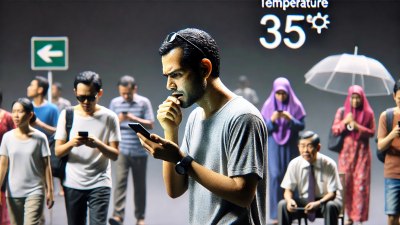How the Sun Keeps Catching You in Mid-Overheat
Explore how the sun's intense heat affects the human body during overheating and learn ways to stay safe under extreme heat conditions.

When temperatures soar and a scorching sun beats down relentlessly, the human body faces a formidable challenge: maintaining its internal temperature within a safe range. The phenomenon of overheating, or heat stress, becomes a pressing issue, especially during extended exposure to direct sunlight. But what exactly happens within the body when the sun's relentless rays catch you mid-overheat?
Understanding this interaction involves delving into how the sun contributes to heat gain, how the body attempts to dissipate this excess heat, and where these processes might falter, leading to adverse effects such as heat exhaustion or heat stroke.
The Sun’s Role in Body Heat Gain
The sun emits electromagnetic radiation, which the earth’s atmosphere partially filters out, but a significant portion reaches us as visible light, ultraviolet (UV), and infrared radiation. Of these, infrared radiation plays a key role in heat transfer. When your skin absorbs sunlight, it converts this energy into heat, elevating the skin’s temperature and consequently, the body's core temperature.
Moreover, visible and UV light indirectly contribute to this warming by increasing the ambient temperature and causing surfaces around you—such as roads, buildings, and soil—to emit stored heat, further raising the surrounding air temperature. This combination of direct radiation and ambient air warming creates an environment conducive to overheating.
The Body’s Heat Regulation Mechanisms
The human body maintains its internal temperature around 37 degrees Celsius (98.6 degrees Fahrenheit) through a balance of heat production and heat loss. When external temperatures rise, especially under strong solar radiation, the body employs several mechanisms to shed excess heat and avoid damage.
One primary method is vasodilation, where blood vessels near the skin surface widen, increasing blood flow to the skin. This process allows heat from the blood to dissipate into the environment effectively. Additionally, sweating is crucial; as sweat evaporates from the skin, it removes heat, cooling the body efficiently.
However, these mechanisms are highly dependent on environmental conditions such as humidity, air movement, and available moisture. High humidity impairs sweat evaporation, reducing cooling efficiency, while stagnant air limits convective heat loss. This interplay can make it difficult for the body to counterbalance the heat from the sun.
Mid-Overheat Events Explained
Mid-overheat refers to the stage where the body’s internal temperature begins to rise above normal but has not yet reached critical levels that cause heat stroke. It often occurs during prolonged sun exposure, physical activity, or in environments where cooling mechanisms are compromised.
During this phase, your skin might start to feel uncomfortably warm, sweating increases, and sometimes, you may experience symptoms such as dizziness, fatigue, headaches, or rapid heartbeat. This is the sun ‘catching you’ mid-overheat, pushing your thermoregulation system towards its limits.
Physiologically, at this point, the body is still struggling to shed the excess heat, but as the sun continues to radiate energy and ambient heat remains high, the mechanisms may become insufficient. If cooling fails, core temperature rises leading to heat exhaustion or, more dangerously, heat stroke.
Why Does the Sun Seem to ‘Catch’ You?
The sensation of the sun ‘catching’ you in mid-overheat is tied to how quickly heat accumulates compared to how effectively the body cools down. On a moderately hot day, your thermoregulation can usually compensate for the heat gain. However, under intense solar radiation combined with high ambient temperature and humidity, heat gain can outpace loss rapidly.
This imbalance causes the core temperature to climb, and you feel the sun’s effects intensify, which metaphorically is often described as the sun catching you. The severity depends on factors such as duration of exposure, your physical condition, hydration level, clothing, and even your location’s altitude and latitude.
Factors Amplifying the Sun’s Impact During Heat Exposure
Several factors can exacerbate the body's heat gain under the sun:
- Clothing: Dark or heavy clothing absorbs more heat and reduces sweat evaporation.
- Dehydration: Without adequate water, the body reduces sweat output, undermining evaporative cooling.
- Physical Activity: Exercise produces internal heat, adding to solar heat absorption.
- Urban Heat Islands: Cities tend to retain heat because of concrete and asphalt, elevating ambient temperatures.
- Medication and Health Conditions: Some drugs and illnesses impair thermoregulation or fluid balance.
Biological Implications of Overheating
Prolonged or intense overheating can cause several biological and physiological disruptions. Elevated core temperatures can lead to protein denaturation, enzyme dysfunction, and cellular stress. The cardiovascular system becomes strained as it works harder to pump blood to the skin to facilitate heat dissipation. This can reduce blood flow to vital organs, potentially causing dizziness or fainting.
Moreover, severe heat exposure can cause electrolyte imbalances through excessive sweating, disturbing nerve and muscle functions. Heat exhaustion manifests as muscle cramps, weakness, fatigue, and nausea. If unchecked, these conditions escalate to heat stroke—characterized by failure of the body's thermoregulation, loss of consciousness, and potentially fatal outcomes without prompt treatment.
How to Prevent the Sun from Catching You in Mid-Overheat
Preventing overheating requires proactive measures to minimize heat gain and maximize heat dissipation. Here are effective strategies:
- Stay Hydrated: Drink water regularly to support sweating and cardiovascular function.
- Wear Appropriate Clothing: Lightweight, light-colored, and breathable fabrics reflect sunlight and facilitate evaporation.
- Take Breaks in Shade or Cool Areas: Reducing direct sun exposure lowers radiation heat load.
- Avoid Peak Sun Hours: The sun’s intensity peaks between 10 a.m. and 4 p.m.; try to limit outdoor activities during this window.
- Use Sunscreen: Protects skin from UV damage but does not prevent heat; it is still vital to combine with other cooling measures.
- Use Fans or Cooling Devices: Air movement enhances convective and evaporative cooling.
- Acclimate Gradually: Allow your body time to adjust to heat exposure over days or weeks.
Technological Innovations and Sun Heat Exposure
Recent advancements in technology have led to improved protective gear and wearable sensors that help monitor body temperature and hydration. Specialized clothing with reflective surfaces or cooling fabrics can reduce heat absorption. Cooling vests and portable misting devices offer additional relief in extreme conditions.
Moreover, smartphone apps enable people to track local heat indexes, providing warnings when the risk of overheating is high. Such tools help individuals make informed decisions to avoid dangerous sun exposure timings.
The Role of Environment and Architecture
Urban planning and building design also influence how much solar heat people absorb. Shade trees, reflective rooftops, and green spaces reduce heat absorption at ground level. Designing cities with ventilation corridors promotes airflow and reduces urban heat island effects.
Indoors, effective insulation and air conditioning can shield inhabitants from external heat, but energy consumption and accessibility remain concerns in many parts of the world. Innovative passive cooling techniques, like green roofs and natural ventilation, provide sustainable solutions to reduce solar heat impact.
Psychological and Behavioral Factors Influencing Overheat Risk
Human behavior plays a significant role in heat exposure risk. People engaged in outdoor recreational activities may underestimate sun intensity or overestimate their heat tolerance. Awareness campaigns and education about signs of overheating and appropriate self-care are crucial.
Moreover, societal factors such as work demands, lack of access to cooling facilities, and socio-economic status affect individuals’ ability to protect themselves from overheating. Vulnerable populations, including the elderly, children, and those with chronic illnesses, require special attention and support during heat waves.
Adapting to a Warming World
Climate change is increasing the frequency and intensity of heatwaves globally, amplifying the challenges posed by solar heat exposure. Understanding how the sun ‘catches’ us mid-overheat underscores the importance of developing adaptive strategies to safeguard health.
Communities must invest in infrastructure, public health initiatives, and education focused on heat resilience. Preparedness plans that include early warning systems, community cooling centers, and provision of drinking water are becoming indispensable in many regions.
Individual actions combined with systemic approaches are essential to mitigate the health risks of solar heat exposure and protect lives as the planet’s climate continues to warm.
In essence, the sun’s scorching presence during periods of overheating is a complex interaction between environmental conditions and human physiology. By recognizing the signs and implementing preventive strategies, it is possible to avoid the severe consequences of heat stress and maintain well-being under the sun’s relentless gaze.











